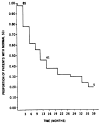Acute and chronic renal failure in liver transplantation
- PMID: 2362625
- PMCID: PMC2957102
- DOI: 10.1159/000185938
Acute and chronic renal failure in liver transplantation
Abstract
We have performed a retrospective review of the incidence and etiologies of acute renal failure (ARF) in 105 adult patients receiving liver transplants. The prevalence of chronic renal failure was also determined. ARF occurred in 94.2% of these patients. Acute tubular necrosis was the leading cause of ARF and was associated with the highest mortality. Factors associated with increased mortality included: (1) peak serum creatinine greater than 3 mg/dl, (2) multiple liver transplants and (3) the need for dialysis. Pretransplant renal failure did not increase mortality. Chronic renal failure developed in 83% of patients at latest follow-up (mean: 30.5 +/- 7.9 months).
Figures




Similar articles
-
Risk factors for development of acute renal failure after liver transplantation.Ren Fail. 2003 Jul;25(4):553-60. doi: 10.1081/jdi-120022546. Ren Fail. 2003. PMID: 12911159
-
Risk factors of acute renal failure after orthotopic liver transplantation: single-center experience.Transplant Proc. 2014 Oct;46(8):2786-9. doi: 10.1016/j.transproceed.2014.09.044. Transplant Proc. 2014. PMID: 25380918
-
Postliver transplant acute renal injury and failure by the RIFLE criteria in patients with normal pretransplant serum creatinine concentrations: a matched study.Transplantation. 2011 Feb 15;91(3):348-53. doi: 10.1097/TP.0b013e31820437da. Transplantation. 2011. PMID: 21127462
-
Acute renal failure and chronic kidney disease following liver transplantation.Hemodial Int. 2007 Oct;11 Suppl 3:S7-12. doi: 10.1111/j.1542-4758.2007.00223.x. Hemodial Int. 2007. PMID: 17897111 Review.
-
Acute renal failure after cardiac surgery for carcinoid heart disease: incidence, risk factors, and prognosis.Am J Kidney Dis. 2005 May;45(5):826-32. doi: 10.1053/j.ajkd.2005.02.009. Am J Kidney Dis. 2005. PMID: 15861347 Review.
Cited by
-
The effects of intraoperative cryoprecipitate transfusion on acute renal failure following orthotropic liver transplantation.Hepatol Int. 2013 Jul;7(3):901-9. doi: 10.1007/s12072-013-9457-9. Epub 2013 Aug 2. Hepatol Int. 2013. PMID: 26201928 Free PMC article.
-
Incidence and Impact of Acute Kidney Injury after Liver Transplantation: A Meta-Analysis.J Clin Med. 2019 Mar 17;8(3):372. doi: 10.3390/jcm8030372. J Clin Med. 2019. PMID: 30884912 Free PMC article.
-
Conversion from cyclosporine to FK 506 in liver allograft recipients with cyclosporine-related complications.Transplant Proc. 1990 Feb;22(1):6-12. Transplant Proc. 1990. PMID: 1689901 Free PMC article. No abstract available.
-
Prophylactic use of OKT3 in liver transplantation. A review.Dig Dis Sci. 1991 Oct;36(10):1427-30. doi: 10.1007/BF01296810. Dig Dis Sci. 1991. PMID: 1914765 Free PMC article. Review.
-
The effect of graft function on FK506 plasma levels, dosages, and renal function, with particular reference to the liver.Transplantation. 1991 Jul;52(1):71-7. doi: 10.1097/00007890-199107000-00015. Transplantation. 1991. PMID: 1713365 Free PMC article.
References
-
- Shear L, Kleinerman J, Gabuzda G. Renal failure in patients with cirrhosis of the liver. Am J Med. 1965;39:184–209. - PubMed
Publication types
MeSH terms
Substances
Grants and funding
LinkOut - more resources
Full Text Sources
Medical
